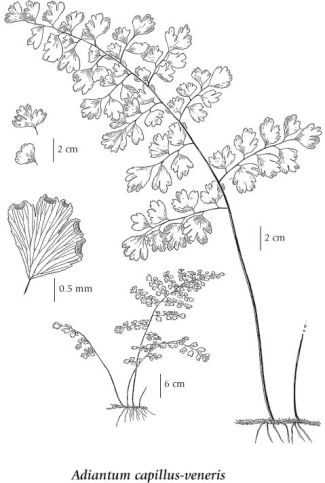Adiantum capillus-veneris L.
southern maiden-hair (common maidenhair)
Pteridaceae (Maidenhair Fern family)
Introduction to Vascular Plants
southern maiden-hair (common maidenhair)
Pteridaceae (Maidenhair Fern family)
Introduction to Vascular Plants
Map
Distribution of Adiantum capillus-veneris
Click here to view the full interactive map and legend
Species Information
General:
Perennial from a slender, black-tinged rhizome.
Leaves:
Oval, 5-30 cm long, oval in outline, borne on smooth dark stipes, pinnately 2- to 3-times divided, the segments fan-shaped, 0.5-3 cm long, 0.5-3 cm wide, obtusely lobed.
Illustration

If more than one illustration is available for a species (e.g., separate illustrations were provided for two subspecies) then links to the separate images will be provided below. Note that individual subspecies or varietal illustrations are not always available.
Illustration Source: The Illustrated Flora of British Columbia
USDA Species Characteristics
Flower Colour:
White
Blooming Period:
Summer
Fruit/Seed characteristics:
Colour: Brown
Present from Summer to Fall
Source: The USDA
Ecology
Ecological Framework for Adiantum capillus-veneris
The table below shows the species-specific information calculated from
original data (BEC database) provided by the BC Ministry of Forests and Range.
(Updated August, 2013)
The table below shows the species-specific information calculated from
original data (BEC database) provided by the BC Ministry of Forests and Range.
(Updated August, 2013)
| Site Information |
Value / Class |
||
|
Avg |
Min |
Max |
|
| Elevation
(metres) |
1433 | 1433 | 1433 |
| Slope
Gradient (%) |
26 | 26 | 26 |
|
Aspect (degrees) |
110 | 110 | 110 |
| Soil
Moisture Regime (SMR) [0 - very xeric; 4 - mesic; 8 - hydric] |
4 | 4 | 4 |
| Modal
Nutrient Regime
Class |
C | ||
| #
of field plots species was recorded in: |
1 | ||
| Modal
BEC Zone Class |
ICH | ||
|
All BEC Zones (# of stations/zone) species was recorded in |
ICH(1) | ||
|
Source:
Klinkenberg 2013
|
|||
Habitat and Range
Wet rock walls in the montane zone; rare in E BC (Fairmont Hot Springs); cosmopolitan, disjunct, S to ME, NH, PA, NC, FL, MS, LA, TX, NM, AZ and CA; Europe, S Asia, Africa, S America, Australia.Status Information
| Origin Status | Provincial Status | BC List (Red Blue List) | COSEWIC |
|---|---|---|---|
| Native | S1 | Red | E (May 2011) |
BC Ministry of Environment: BC Species and Ecosystems Explorer.
Synonyms
Synonyms and Alternate Names:
Adiantum capillus-veneris var. modestum (Underw.) Fernald
Adiantum capillus-veneris var. protrusum Fernald
Adiantum modestum Underw.
Similar Species
Adiantum capillus-veneris can be distinguished from Adiantum aleuticum, the only other Adiantum species in B.C., by its lax drooping habit, unbranched stem, arrangement of pinnae on both sides of the stem, and pinnules that are oval to fan-shaped (Brunton 1984). A. aleuticum is a taller, upright fern, which has a palmately-branched (equally two-forked) stem with oblong, almost rectangular (2-4 times longer than wide) pinnules. The two Adiantum species are not likely to be confused because they occupy different habitats: A. aleuticum occupies shaded acidic woods and rocky slopes while A. capillus-veneris is a calciphile, growing in seepy sites on calcareous rocks, including tufa (Brunton 1984).
Source: British Columbia Conservation Data Centre |